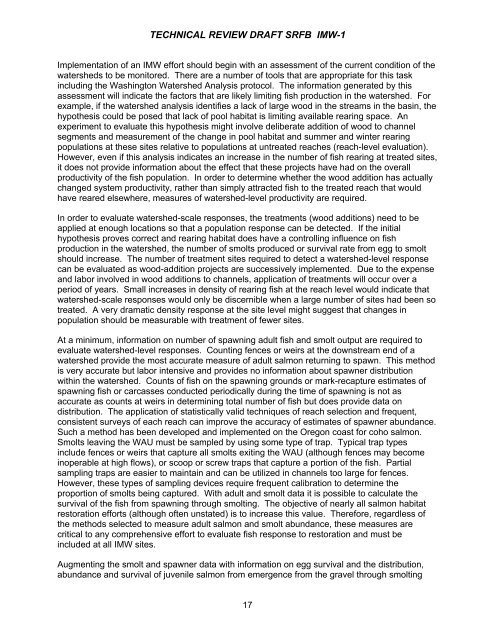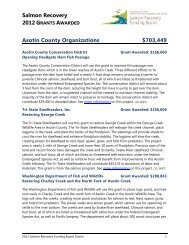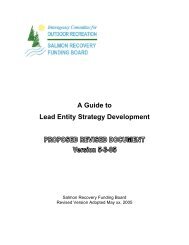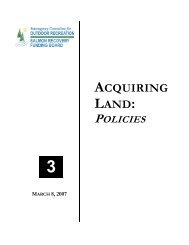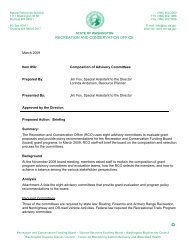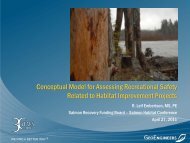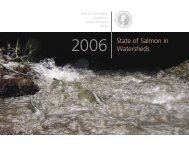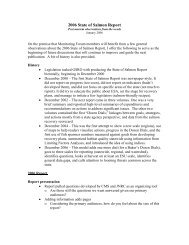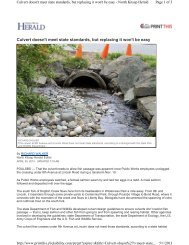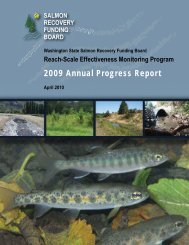Proposal to Establish Intensively Monitored Watersheds for ...
Proposal to Establish Intensively Monitored Watersheds for ...
Proposal to Establish Intensively Monitored Watersheds for ...
- No tags were found...
You also want an ePaper? Increase the reach of your titles
YUMPU automatically turns print PDFs into web optimized ePapers that Google loves.
TECHNICAL REVIEW DRAFT SRFB IMW-1Implementation of an IMW ef<strong>for</strong>t should begin with an assessment of the current condition of thewatersheds <strong>to</strong> be moni<strong>to</strong>red. There are a number of <strong>to</strong>ols that are appropriate <strong>for</strong> this taskincluding the Washing<strong>to</strong>n Watershed Analysis pro<strong>to</strong>col. The in<strong>for</strong>mation generated by thisassessment will indicate the fac<strong>to</strong>rs that are likely limiting fish production in the watershed. Forexample, if the watershed analysis identifies a lack of large wood in the streams in the basin, thehypothesis could be posed that lack of pool habitat is limiting available rearing space. Anexperiment <strong>to</strong> evaluate this hypothesis might involve deliberate addition of wood <strong>to</strong> channelsegments and measurement of the change in pool habitat and summer and winter rearingpopulations at these sites relative <strong>to</strong> populations at untreated reaches (reach-level evaluation).However, even if this analysis indicates an increase in the number of fish rearing at treated sites,it does not provide in<strong>for</strong>mation about the effect that these projects have had on the overallproductivity of the fish population. In order <strong>to</strong> determine whether the wood addition has actuallychanged system productivity, rather than simply attracted fish <strong>to</strong> the treated reach that wouldhave reared elsewhere, measures of watershed-level productivity are required.In order <strong>to</strong> evaluate watershed-scale responses, the treatments (wood additions) need <strong>to</strong> beapplied at enough locations so that a population response can be detected. If the initialhypothesis proves correct and rearing habitat does have a controlling influence on fishproduction in the watershed, the number of smolts produced or survival rate from egg <strong>to</strong> smoltshould increase. The number of treatment sites required <strong>to</strong> detect a watershed-level responsecan be evaluated as wood-addition projects are successively implemented. Due <strong>to</strong> the expenseand labor involved in wood additions <strong>to</strong> channels, application of treatments will occur over aperiod of years. Small increases in density of rearing fish at the reach level would indicate thatwatershed-scale responses would only be discernible when a large number of sites had been sotreated. A very dramatic density response at the site level might suggest that changes inpopulation should be measurable with treatment of fewer sites.At a minimum, in<strong>for</strong>mation on number of spawning adult fish and smolt output are required <strong>to</strong>evaluate watershed-level responses. Counting fences or weirs at the downstream end of awatershed provide the most accurate measure of adult salmon returning <strong>to</strong> spawn. This methodis very accurate but labor intensive and provides no in<strong>for</strong>mation about spawner distributionwithin the watershed. Counts of fish on the spawning grounds or mark-recapture estimates ofspawning fish or carcasses conducted periodically during the time of spawning is not asaccurate as counts at weirs in determining <strong>to</strong>tal number of fish but does provide data ondistribution. The application of statistically valid techniques of reach selection and frequent,consistent surveys of each reach can improve the accuracy of estimates of spawner abundance.Such a method has been developed and implemented on the Oregon coast <strong>for</strong> coho salmon.Smolts leaving the WAU must be sampled by using some type of trap. Typical trap typesinclude fences or weirs that capture all smolts exiting the WAU (although fences may becomeinoperable at high flows), or scoop or screw traps that capture a portion of the fish. Partialsampling traps are easier <strong>to</strong> maintain and can be utilized in channels <strong>to</strong>o large <strong>for</strong> fences.However, these types of sampling devices require frequent calibration <strong>to</strong> determine theproportion of smolts being captured. With adult and smolt data it is possible <strong>to</strong> calculate thesurvival of the fish from spawning through smolting. The objective of nearly all salmon habitatres<strong>to</strong>ration ef<strong>for</strong>ts (although often unstated) is <strong>to</strong> increase this value. There<strong>for</strong>e, regardless ofthe methods selected <strong>to</strong> measure adult salmon and smolt abundance, these measures arecritical <strong>to</strong> any comprehensive ef<strong>for</strong>t <strong>to</strong> evaluate fish response <strong>to</strong> res<strong>to</strong>ration and must beincluded at all IMW sites.Augmenting the smolt and spawner data with in<strong>for</strong>mation on egg survival and the distribution,abundance and survival of juvenile salmon from emergence from the gravel through smolting17


